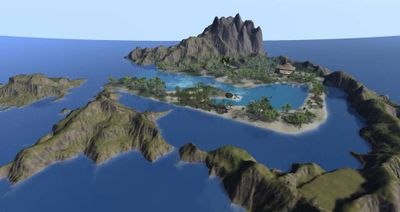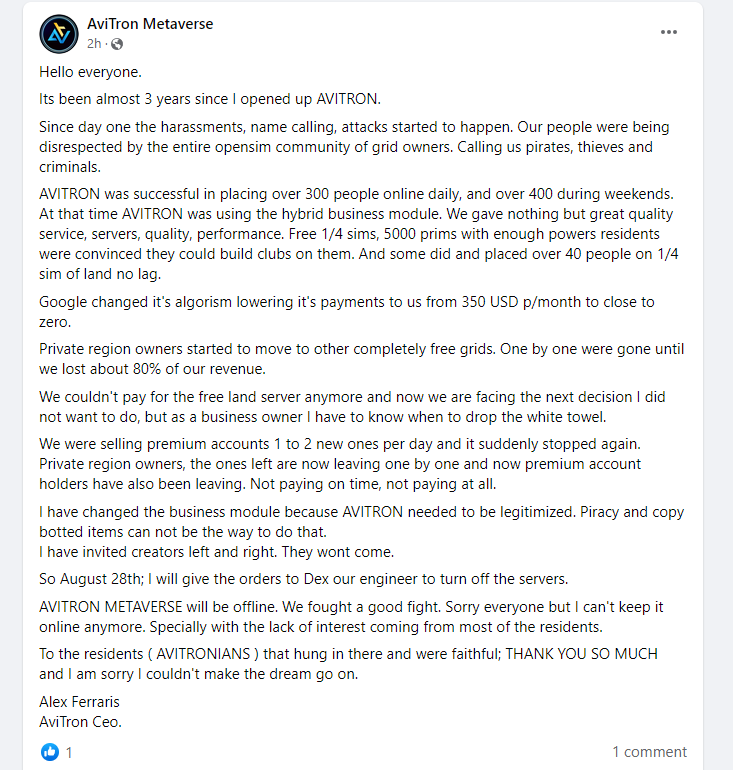
AviTron owner Alexander Pomposelli has a long history of closing grids without warning. Back when he ran AviWorlds, I counted more than a dozen times that he closed that grid, often without any warning. Residents complained of losing access to regions, inventories, and in world-currency balances.
At one point, he finally gave up, and turned AviWorlds over to former business partner Josh Boam — then started AviTron. But before he launched AviTron, he briefly ran the Virtual Ville grid, which he shut down without warning in October of 2020.
Well, AviTron may be closing at the end of the month.
“Yes, I am closing AviTron at the end of the month,” Pomposelli told Hypergrid Business. “AviTron is a business and it lost over 80 percent of its revenues… After three years online I couldn’t make it legit. Lost money every month.”
Residents have until August 28 to take their content from AviTron and move it to other grids, he said. To enable this process, AviTron will become hypergrid-enabled. The hypergrid address is e avitronlogin.avitron.net:8002.
However, any currency reserves that residents had on the grid will not be exchangeable, he said.
Residents learned about the closure on AviTron’s Facebook page.
“Private region owners, the ones left are now leaving one by one and now premium account holders have also been leaving. Not paying on time, not paying at all,” Pomposelli wrote in a Facebook post yesterday.
Several people sent me copies of that announcement last night.
Then, this afternoon, Pomposelli contacted me again.
“I may just cut costs and keep it online,” he said. “I am studying it. But it cannot be the way it is now.”
The yo-yo grid
Back when I was co-hosting the Inworld Review with Mal Burns, Burns referred to AviWorlds as the “yo-yo grid” because it kept going up and down.
Today, AviWorlds, under new management, has been very stable and has recently passed its 5,000th registered user.
So maybe it’s not so much the grid that’s the yo-yo grid as the owner.
This is just my opinion, but, based on 14 years of covering OpenSim, it doesn’t help when your business model changes month-by-month and residents never know what to expect.
OpenSim grids typically fall into one of two categories. On the one hand, there are commercial grids. They offer reasonably-priced land and good service and are careful about managing their technology and expenses. Several have been up and running for years, with little or no downtime, by providing consistent value and service.
Other grids are run by groups, non-profits and individuals and rely heavily on volunteers. They might break even on costs, or accept donations, or just cover the server expenses themselves because OpenSim is cheaper than renting land on Second Life. Roleplaying groups and educational institutions, for example, can get a lot of inexpensive land in OpenSim and a great deal of control when they run their own grids. These grids often offer free or subsidized land to users, employees, or community members.
Commercial grids rarely offer free land and, when they do, it’s usually smaller parcels designed for residential use or for setting up stores.
Grids also typically pick whether or not they will be hypergrid enabled and then stick with that decision. Schools and private role-playing grids, for example, might choose not to be hypergrid-enabled because they want to ensure the safety of their students or to secure proprietary content.
General-purpose grids tend to hypergrid-enabled, allowing users to teleport in and out. This means that people don’t have to create new accounts in order to visit the grid, and allows people to send messages to friends on other grids. It also makes it easier for residents to get content deliveries from the Kitely Market, or to go shopping on other grids. As of mid-July, more than 98 percent of all public OpenSim users were on hypergrid-enabled grids.
AviTron is an exception. The grid has changed business models several times, with Pomposelli changing his mind on whether to allow hypergrid travel, or whether users can export content — such as their own creations — from the grid. He’s also experimented with NFTs, cryptocurrency, free land, and paying users to spend time on the grid. He’s also changed currency providers. AviTron has also experienced some downtime, including a protracted outage in 2021.
It seems that he can’t decide whether he’s running a personal grid, paid for out of his own pocket, or a commercial grid sustained by a steady revenue stream.
He also claims to have made money from Google Ads. In his Facebook post, he said he was seeing $350 a month in advertising revenues. This is a very odd statement — you’d need to have at least 10,000 pageviews a month, and usually a lot more, to make any significant money from ads. We certainly weren’t getting anywhere near that when we had ads up on Hypergrid Business, and we typically have over 30,000 pageviews a month. OpenSim’s total active user base is only 43,000 a month.
In general, grid websites don’t see much traffic. People come once or twice — to learn about the grid, and to open an account. Then, after that, all their interactions are in-world. Even the most popular grid wouldn’t see more than a few hundred visitors a month unless they had a particularly active forum or blog. AviTron did not.
Warning to future AviTron users
If AviTron does stay alive — or closes and then comes back from the dead — I strongly urge users not to invest more time and money than they can afford to lose.
If AviTron is hypergrid-enabled, I recommend that people base their primary avatar on another, more stable grid — such as OSgrid, Kitely, or DigiWorldz.
And if you need free land, get a free OSgrid region that you run on a home computer, or download the DreamGrid installer. If you own your own region, you can save it as an OAR file at any time. This is what I recommend for content creators, whether in OpenSim or Second Life — do your building and creation on a private, personal region or grid, then upload the creations to the commercial grids where you plan to use or sell them.
- OSgrid back online after extended maintenance - April 16, 2025
- Analysts predict drop in headset sales this year - March 25, 2025
- OSgrid enters immediate long-term maintenance - March 5, 2025

